Even if we are already a little aware of records and what they seem to be about, or even if we are somewhat wise about the sizes and relative speeds of records and at which they need to be played respectively, I suppose it can be a little difficult to get one’s head round how these things relate to one another. However, with the handy help of a vinyl record size chart we ought to be more than adequately equipped to take on the task.
This is what we intend to take aim at today, as well as what we intend to take at it with! So, follow us as we explore these sizes and speeds in detail…
Vinyl Record Speeds: A Quick Recap
Before we go on to discuss the three main sizes that might appear on a vinyl record size chart, we must first wrap our heads around the three central speeds at which these kinds of record sizes will typically be played at to ensure that they are played back as close as possible to the source audio as dictated by the artist and the producer.
45 Revolutions Per Minute
45 rpm records were originally manufactured to be played on the smallest of the more typical record sizes, that of the 7 inch disc, which is itself almost half the size of the largest of the most typical sizes, the 12 inch disc. The holistic aim was most likely to provide music consumers with a more transportable medium upon which to press higher quality versions of single songs in small bunches.
33 1 / 3 Revolutions Per Minute
Soon after they were drafted into the mainstream realm, records that were intended to be played at 33 1 / 3 rpm – most commonly being on 12 inch discs – superseded the 7 inch 45 rpm record as the standard currency for exchanging sounds between producer and consumer, even remaining so to this day.
78 Revolutions Per Minute
Records have better sound quality the faster they are played, though in turn a faster rpm will mean inherently less space on the disc with which to hold the music. Whether or not this is a worthy sacrifice is constantly up for debate between those more contentious vinyl enthusiasts, though the times have made their bed and now lie in it, with this speed being rare if not completely unheard of in the more modern era of vinyl production and consumption.
Vinyl Record Size Chart: A Rough Guide
Though there are theoretically an infinite amount of sizes and styles of record, there are but three main sizes that you are likely to find when out and about scouring your local record store. Of these three sizes, you are much more likely to find two than one of the others. The reasons for this are inherently tied up to the history of vinyl recording, as well as with the entire history of recording technology itself in fact, and what the vinyl records are, and thus would be difficult to explain in such a short form format.
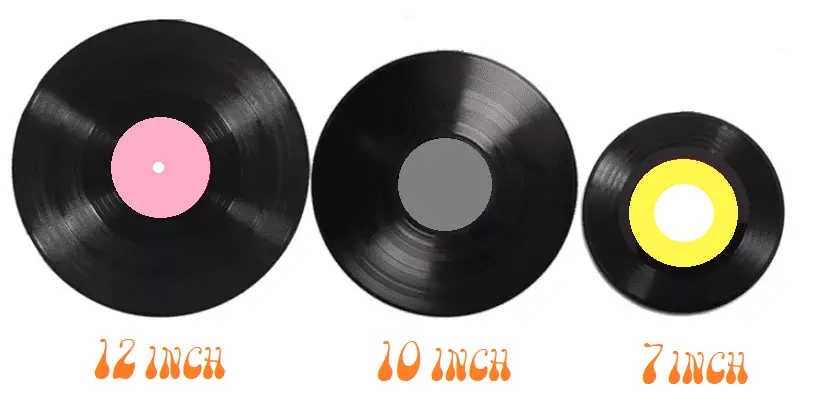
7 Inch Record Size
Without doubt the smallest of the more common vinyl record sizes in a vinyl record size chart, it is a lack in size should not translate into an overall lack of potency or presence, for they can be found everywhere.
7 inch records are usually played at 45 rpm for the sake of improved audio fidelity, for they are the perfect size for holding a single song on each side.
The technical capabilities mean that they are able to hold 4 to 6 minutes on each side, with the capacity increasing to around 7 minutes if played at 33 1 / 3 rpm. Hence why they are often called singles instead of 7 inch records.
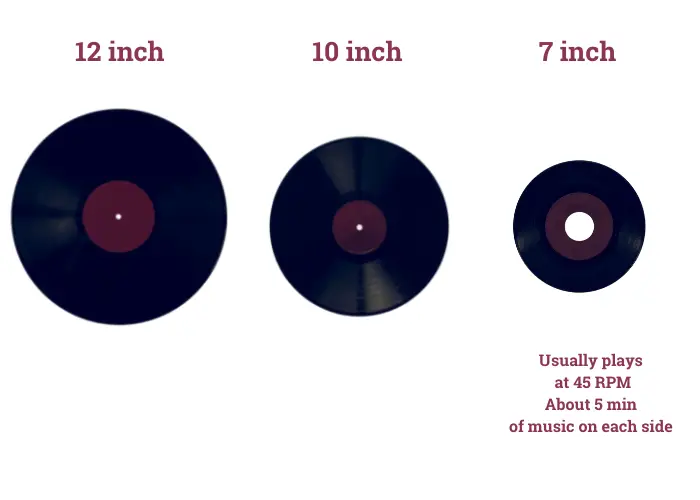
The intention behind the production of smaller discs seems to have been to provide music listeners a more transportable medium upon which to print higher quality versions of singles from albums.
The 7 inch record rapidly became the common currency for the exchange of popular music, able to contain in a smaller format the content from an upcoming release, especially seeing as the 12 inch record was not a seriously considered medium until the 1960s, other than in collating a collection of unrelated singles by an artist or scene.
At the time of its inception, the radio was still the most common way for discovering and exploring all things popular and musical in this period, thus it would more often than not be the case that popular radio hits were stored on 7 inch records.
Used in this way, the discs were only really able to contain one or two songs per side – even the latter happening at a push – so the records quickly acquired the name ‘singles’, which has since become a common term even in this day and age, remaining a convenient way to describe a song released outside of the bounds of a longer release.
12 Inch Record Size
The 12 inch record will more often than not house an entire album, with the usual formation allotting one side of the disc to one half of the album. Also common is the playing of 12 inch records at 33 1 / 3 rpm, for this will mean that there is more space on the record to contain the music which is being released in this longer and larger 12 inch form. In this way, a 12 inch record can hold between 15 to 22 minutes of music per side.
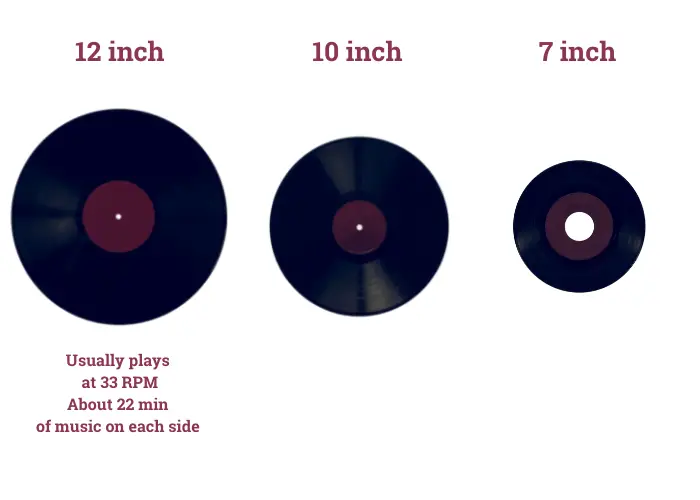
12 inch discs and the idea of playing records at 33 1 / 3 rpm came relatively late in the history vinyl recording, incepted at a time when radios were still the primary source of musical and listening entertainment for the majority of popular consumers.
Though they were and still are relatively unparalleled, if only for being so effective at longer playback times, it should not be hard to see how the 33 1 / 3 rpm playback speed and the 12 inch disc did not exactly have the smoothest start out in the world.
After this less than welcoming inception, in 1948 Columbia Records began touting the 33 1 / 3 rpm record as a technological breakthrough in audio technology, being able to hold ‘whole classical performance and symphonies on just one side of a 12 inch disc without the need to interrupt the listening experience’ to flip the disc, and with the inevitable need to flip the disc between movements providing a necessary break between movements to stop and think carefully on them, as one might at an actual concert.
Equating this format with the standards of the western classical elite in this way instantly imbibed the form with a new standing among the scholars of the music community, touted as being able to hold what is considered by many such scholars to be the pinnacle of artistic achievement in the musical sphere, bloating the self confidence of this record size in a vinyl record size chart without doubt.
10 Inch Record Size
You certainly will not be seeing as much of the 10 inch record out and about when record shopping than its 12 inch and 7 inch brethren, owing to advances in the format and the passage.
In being arguably the most liminal record size on a vinyl record size chart with a run time of 12 to 15 minutes at 33 1 / 3 rpm and 9 to 12 minutes at 45 rpm, there are no doubts as to the liminality of the medium in between its larger and smaller brethren.
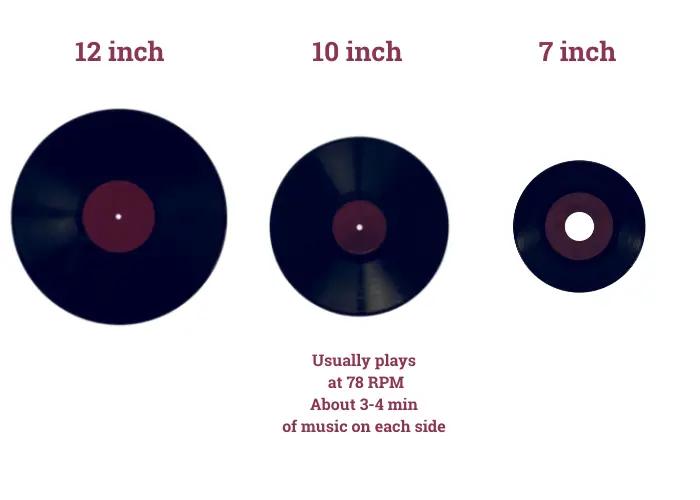
However, seeing as attention spans become shorter and shorter, barely surviving til the end of a sentence or sequence of notes in some cases, I might suggest that this liminal size and subsequently liminal playback time ought to be capitalised upon more.
Emile Berliner, the inventor of the gramophone record and accompanying record player, invented records that were played between 70 and 80 RPM, which gave birth to a precedent which was followed pretty strictly, up to the point that 78 rpm became the industry standard throughout the western world by the year of 1925.
While the sizes of the original 78 rpm records would vary between brand to brand, they were more often than not rendered on 10 inch records so as to accommodate for the shorter playback time, and this eventually became the standard size for records played at this speed.
This size of record was gradually phased out, and not just for the less than adequate playback time offered, and so 10 inch records and 78 rpm playback speeds are rarely produced anymore.
Even older record players and turntables are less and less likely to be found with a setting to play them, meaning that, if they were produced, they wouldn’t have as much of an audience, despite any claims of better fidelity by one’s resident audiophile.
Vinyl Record Size Chart: The Cover Itself
Any artist releasing music in an album should aim for a high picture quality when producing the corresponding album art, regardless of the original fidelity of the image. This is especially true for the dimensions of a record, for the artwork is going to be enlarged by significant proportions, 12.375 inches by 12.375 inches to be exact – ever so slightly larger than the 12 inch disc itself (a vital nugget of information when calculating the dimensions of vinyl record cover).

I have seen and / or bought several new and used records in my time whose cover sleeve have had significant portions lost to a low bit rate and an unacceptably low number of pixels, which goes toward obscuring the overall quality of the image to a degree that ought to be noticeable by even the most untrained ear.
The record is an altogether different beast, and so it can be easy to neglect that fact, and the fact that with a much larger surface area comes a greater likelihood of visual distortions. Those that were there already are exacerbated and those that were too negligible to see before are brought to the fore.
This does, however, seem to be a problem that plagues more independent record labels and producers than the larger, more conglomerate labels. It is a crippling misery pity to think on for too long, though it does render it all the more significant and special when an independent label really does take these things seriously. It is, after all, within the details that the devil lies and can often be found preying on the predator who preys on the weak.
Final Tones
So, there you have it! Hopefully you are now somewhat the wiser about how to navigate all of the various record sizes and the speeds at which they are intended to be played with the handy help of a vinyl record size chart. Perhaps, you are even ready to try your hand at spinning a record size that you have never used or bought before, or even to spin them at a different speed than you are otherwise used to. Though a little experimental sometimes, this can totally revolutionise the way you hear music, perfect for hearing a song anew that you have already heard countless times.
FAQs Vinyl Record Size Chart
What’s the difference between 33 45 and 78 records?
The central difference lies in the speed at which they are played in order to produce as close as possible a rendering of the sound imbibed within a record’s grooves as was initially intended by the artist and producer behind the release. These varying speeds, however, will tend to mean a varying array of record sizes, of which two or three now reign supreme. A recording intended to be played back at 33 1 / 3 rpm, for example, will tend to be contained within a 12 inch record disc, which a recording intended to be played back at 45 rpm is more likely to be contained on a 7 inch record disc.
How do I know what size my vinyl record is?
This should hopefully be fairly self explanatory, though I suppose there can be a little difficulty. Certainly, the size differences are rather obvious when comparing the two poles, those of the 7 inch record and the 12 inch records. There is, however, the liminal size of 10 inch records which can be mistaken for a 12 inch record, at least if there is not an actual 12 inch record around for visual reference. Though this can be somewhat difficult and confusing at first, these all ought to be things that the mind makes automatic work of over time.
Are there different size vinyl records?
Indeed there are, and though these different sizes and shapes can certainly vary an awful lot in the realms of possibilities, almost all are constructed from one of three different sizes. The 7 inch record is more often referred to as a ‘single’ and is designed to hold between two and four tracks on the disc’s two sides played at 45 rpm. The 10 inch record is the inbetween, to be played at 78 rpm. The 12 inch record was initially conceived to hold more music, albums and the like, played at 33 1 / 3 rpm so as to bolster this cause even further.
How big is a 78 record?
Though the size of a record that is intended to be played at the speed of 78 rpm can vary considerably, it is more common that it be contained within the bounds of a 10 inch record. This playback speed is, however, far, far less common nowadays than it once might have been. being altogether extinct as far as I have been able to tell in my own peregrinations. My own record collection is by no means as extensive as I would like it to be, but I have a fair number, and among them not one is 10 inches in size nor to be played at 78 rpm.


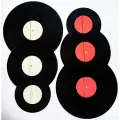
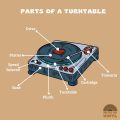


Hi!
1) Are vinyl records with scratches worth anything?
2) Does the cover have to be in pristine condition?
Hey there Rebecca,
Hope this finds you well. The answers to both your questions will depend very much on the desirability and rarity of the records in question. For example, a decidedly rare and desirable record will no doubt fetch a hefty sum no matter how marred the quality of the disc is, just as it will likely garner this sum even if the cover is damaged in some way. That being said, you are going to get far more for a record in pristine condition without scratches no matter the rarity or desirability of the release in question.
Hope this has been of help Rebecca,
Robert.